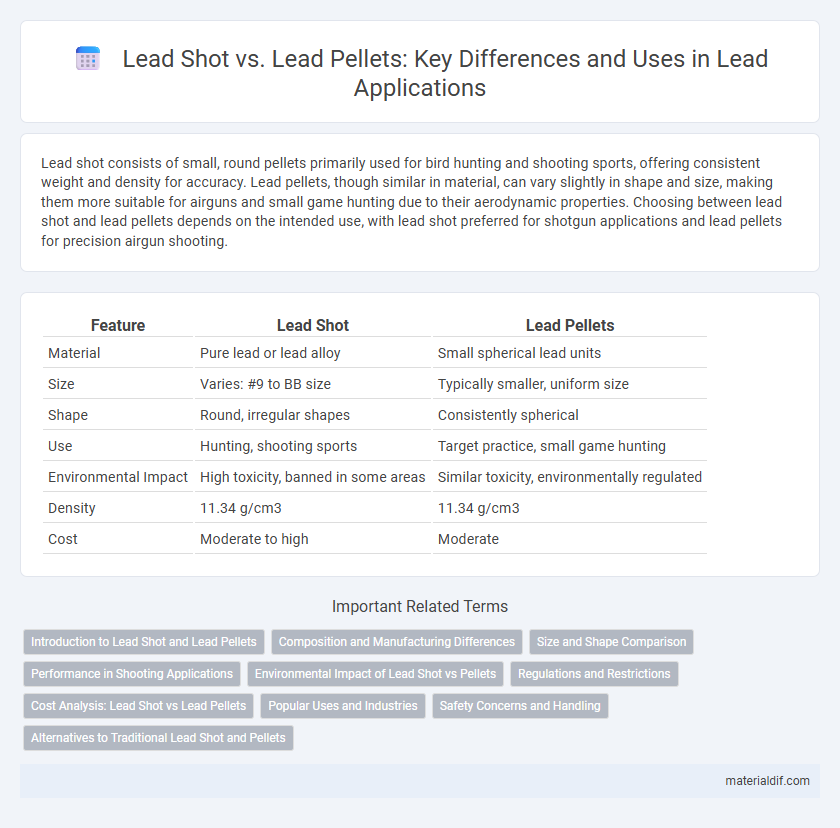Lead shot consists of small, round pellets primarily used for bird hunting and shooting sports, offering consistent weight and density for accuracy. Lead pellets, though similar in material, can vary slightly in shape and size, making them more suitable for airguns and small game hunting due to their aerodynamic properties. Choosing between lead shot and lead pellets depends on the intended use, with lead shot preferred for shotgun applications and lead pellets for precision airgun shooting.
Table of Comparison
| Feature | Lead Shot | Lead Pellets |
|---|---|---|
| Material | Pure lead or lead alloy | Small spherical lead units |
| Size | Varies: #9 to BB size | Typically smaller, uniform size |
| Shape | Round, irregular shapes | Consistently spherical |
| Use | Hunting, shooting sports | Target practice, small game hunting |
| Environmental Impact | High toxicity, banned in some areas | Similar toxicity, environmentally regulated |
| Density | 11.34 g/cm3 | 11.34 g/cm3 |
| Cost | Moderate to high | Moderate |
Introduction to Lead Shot and Lead Pellets
Lead shot consists of small, spherical balls primarily used in shotgun shells for hunting and sport shooting, providing consistent spread and impact. Lead pellets, while similar in composition, vary in shape and size to suit different applications such as airguns or fishing weights, offering versatility in performance. Both materials leverage lead's density and malleability, optimizing projectile effectiveness across diverse shooting disciplines.
Composition and Manufacturing Differences
Lead shot and lead pellets differ primarily in composition and manufacturing processes; lead shot is typically composed of pure lead, while lead pellets often contain alloys such as lead-tin or lead-antimony to enhance hardness. The manufacturing of lead shot involves a process called shot tower dropping, where molten lead forms spherical shapes as it cools during free fall, whereas lead pellets are usually produced through pressing and sintering powdered lead alloys to achieve uniform density and size. These differences affect performance characteristics, with pure lead shot offering greater malleability and cast lead pellets providing increased durability.
Size and Shape Comparison
Lead shot consists of small, spherical pellets typically ranging from 1.5 to 5 millimeters in diameter, offering uniform roundness that ensures consistent aerodynamic behavior. Lead pellets generally vary in size more significantly and can include irregular shapes, which affect their flight path and impact pattern. The spherical shape of lead shot contributes to more predictable spread patterns compared to lead pellets, which are often used for different hunting or shooting applications due to their size variability.
Performance in Shooting Applications
Lead shot offers superior density and consistent size, resulting in higher energy retention and improved accuracy in shooting applications like hunting and target shooting. Lead pellets, commonly used in air rifles, provide better aerodynamics and less barrel wear but generally deliver lower impact energy compared to lead shot. Selecting between lead shot and pellets depends on the specific shooting context, with lead shot favored for greater power and pellets preferred for precision and reduced recoil.
Environmental Impact of Lead Shot vs Pellets
Lead shot and lead pellets differ in environmental impact primarily due to their size and dispersal during hunting, with lead shot presenting a higher risk of soil and water contamination. Lead pellets from smaller calibers tend to fragment more, increasing the likelihood of ingestion by wildlife and bioaccumulation in ecosystems. Research indicates that lead shot residues accumulate in wetland sediments, causing elevated toxicity to aquatic organisms compared to larger lead pellets.
Regulations and Restrictions
Lead shot and lead pellets face increasingly stringent regulations due to environmental and health concerns. Many countries have banned or restricted the use of lead shot in waterfowl hunting to prevent lead poisoning in wildlife, mandating alternatives like steel or bismuth shot. Compliance with local and international laws is essential for hunters, as violations can result in heavy fines and legal action.
Cost Analysis: Lead Shot vs Lead Pellets
Lead shot generally offers a lower cost per unit compared to lead pellets, making it more economical for high-volume shooting activities like bird hunting or target practice. The manufacturing process of lead shot involves pouring molten lead through a sieve to form spherical pellets, which is cost-effective and results in consistent sizes, whereas lead pellets require more intricate molding, increasing production expenses. While both provide similar ballistic performance, the lower raw material and production costs make lead shot the preferred choice for budget-conscious shooters.
Popular Uses and Industries
Lead shot is widely used in hunting and shooting sports, prized for its density and ability to deliver effective impact on game birds. Lead pellets find extensive application in airgun ammunition for target shooting and small pest control due to their uniform size and aerodynamic properties. Both materials are integral in industries such as wildlife management, pest control, and sporting goods manufacturing.
Safety Concerns and Handling
Lead shot poses higher toxicity risks compared to lead pellets due to its smaller size and increased likelihood of ingestion by wildlife and contamination of water sources. Handling lead shot requires strict safety protocols, including wearing gloves and avoiding inhalation of dust to prevent lead poisoning. Lead pellets, though less hazardous, still necessitate careful disposal and minimal direct contact to reduce environmental and health impacts.
Alternatives to Traditional Lead Shot and Pellets
Alternatives to traditional lead shot and pellets include steel, bismuth, and tungsten, which offer environmentally safer options while maintaining performance for hunting and shooting sports. Steel shot is widely used due to its affordability and non-toxic properties, though it is harder and less dense than lead. Bismuth and tungsten pellets provide superior density and ballistic performance, making them effective substitutes without the environmental risks associated with lead contamination.
Lead shot vs Lead pellets Infographic

 materialdif.com
materialdif.com